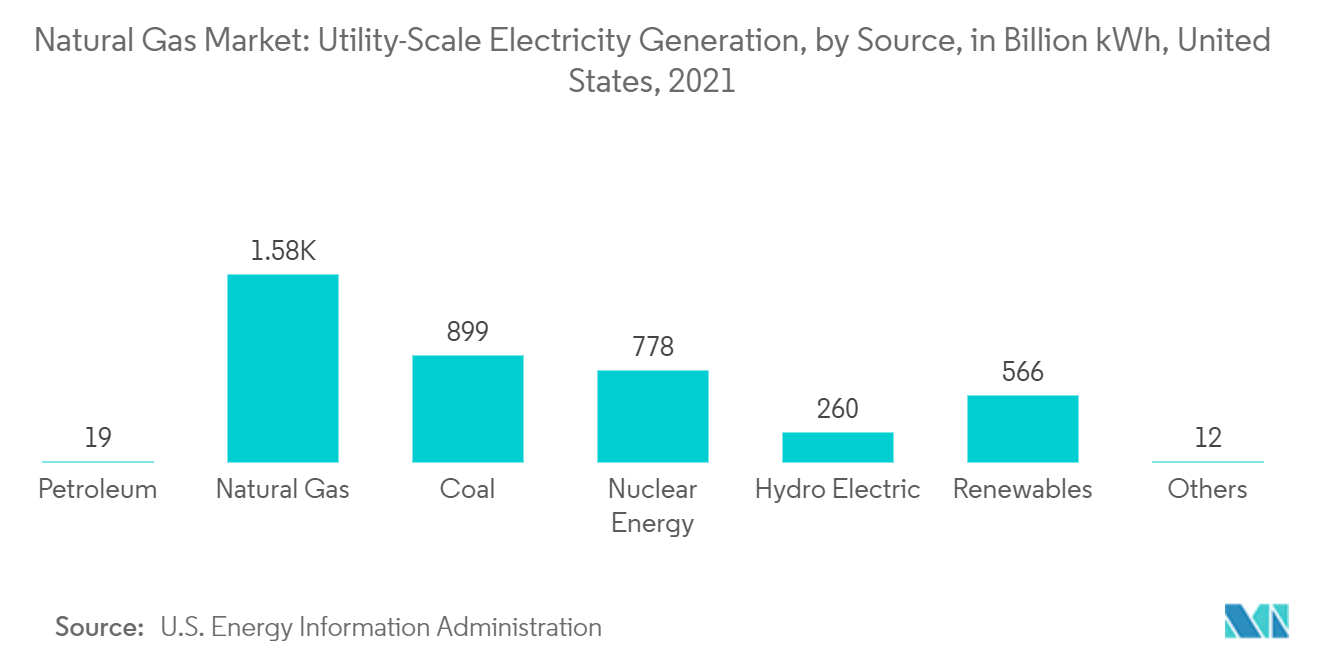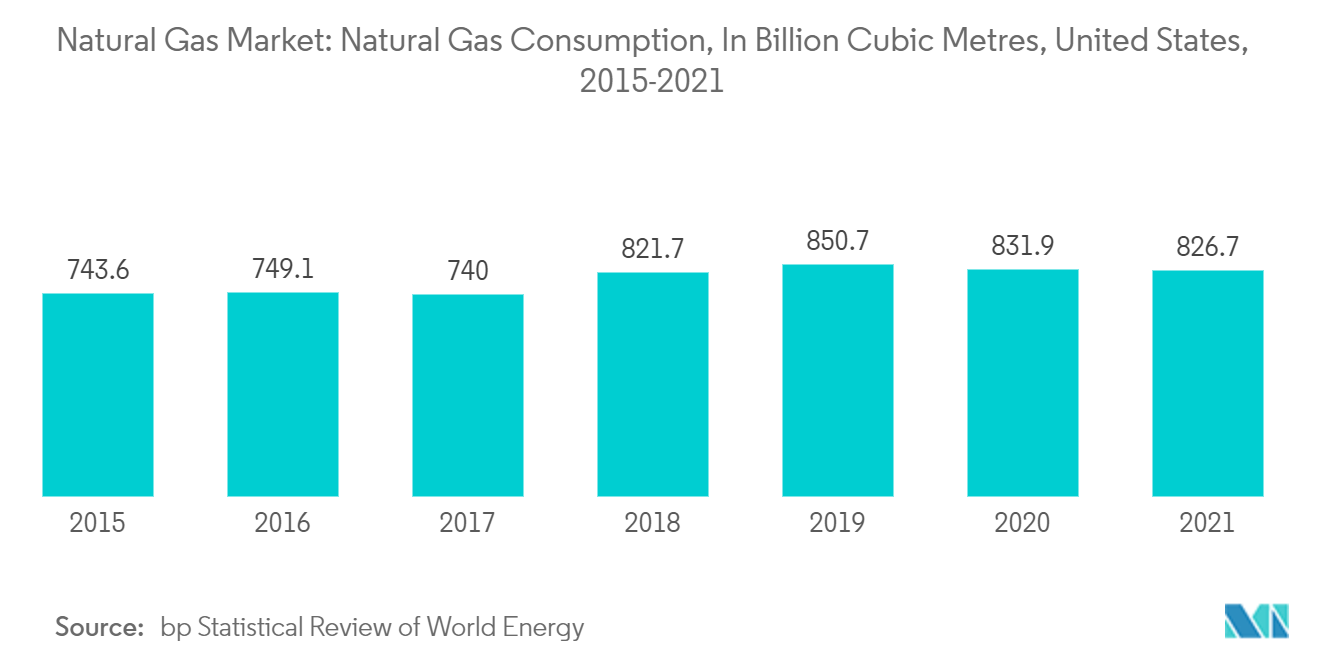Market Trends of United States Natural Gas Industry
This section covers the major market trends shaping the US Natural Gas Market according to our research experts:
Power Generation Segment to Dominate the Market
- A gas-fired power plant, also called a gas-fired power station or natural gas power station, is a thermal power plant that generates electricity by burning natural gas.
- Natural gas power plants are low-cost, quick to build, and have very high thermodynamic efficiencies compared to other power plants. Burning of natural gas churn out fewer pollutants like NOx, SOx, and particulate matter than coal and oil.
- Combined cycle plants are more efficient because they utilize hot exhaust gases from the gas turbine, which are then used to boil water into steam, which can spin another turbine and generate more electricity, resulting in up to 60% thermal efficiency.
- According to the US Energy Information Administration, in 2021, nearly 4,116 billion kilowatt-hours (kWh) of electricity were generated at utility-scale electricity generation facilities in the United States. Most of this electricity was generated by fossil fuels (coal, natural gas, petroleum, and other gases). About 19% of the electricity was generated by nuclear energy, while the remaining 20% was generated by renewable energy.
- According to the US Energy Information Administration, natural gas consumption in the United States is expected to increase by 3.6 billion cubic feet (Bcf/d) in 2022 compared to 2021 levels to an average of 86.6 Bcf/d per year. In addition, the natural gas consumption of the United States in 2022 is expected to rise across all end-use sectors, led by electric power, residential and commercial.
- The largest consumer of natural gas in the United States in 2022 is expected to be the electric power sector, with its annual consumption increasing by 1.2 Bcf/d to average 32.1 Bcf/d, which is 0.3 Bcf/d higher than the previous record set in 2020 of 31.8 Bcf/d. A historical trend shows that this sector is sensitive to changes in natural gas prices concerning coal prices. Power providers typically offset their use of natural gas for electricity generation with coal during times of high natural gas prices.
- Because of limitations at coal-fired power plants and weather-driven demand, the electric power consumption of natural gas in the United States increased in 2022. Due to historically low on-site inventories, constraints in fuel delivery to coal plants, and continued retirements of coal capacity, coal-fired power plants have been unable to increase power generation.
- In February 2022, Baker Hughes and NET Power formed a strategic partnership. According to the partnership, Baker Hughs is investing in NET Power, aiming to advance the deployment of NET Power's utility-scale natural gas-fired power plants, which do not emit any greenhouse gases and capture all CO2. As a result of the partnership, industry experts are brought together to enable the global deployment of NET Power's technology solutions. Baker Hughes may apply its advanced technology capability in developing supercritical CO2 turboexpanders and other critical pumping and compression technologies to NET company's power plants. As part of the partnership, Baker Hughes may contribute its experience in system integration and process knowledge to accelerate market deployment. The NET Power company is engaged in developing utility-scale NET Power plants, with initial projects expected to be online in four years.
- In August 2021, the California Energy Commission (CEC) approved licenses for gas-fired power units to help the state cope with ongoing electricity shortages. In response to the governor's declaration that the state's power grid was in an emergency, the state's Department of Water Resources is procuring five temporary gas-fueled generators, each with a power capacity of 30 megawatts, to be installed at existing power plants.
- Therefore, based on the factors mentioned above, such as the huge consumption of natural gas in the power sector and demand for gas-fired power plants, the Power generation segment is expected to positively impact the natural gas market during the forecast period.

Growing Demand for Cleaner Energy Sources Such as Natural Gas to Drive the Market
- The US shale gas boom has propelled the country into a global leadership position among natural gas producers over the past decade. The United States produced more natural gas than ever in 2021, with 23.1% of the global natural gas production being accounted for by the United States, ahead of Russia (17.4%) and even the entire Middle East (17.7%).
- According to the bp Statistical Review of World Energy, in 2021, the United States consumed 826.7 billion cubic meters of natural gas, an increase of 11.71% from 2017.
- The electric power sector relies on natural gas to generate electricity and thermal output. In 2021, electric power accounted for 37% of the total natural gas consumption in the country, and natural gas accounted for approximately 32% of the primary energy consumption of the US electric power sector. Natural gas accounted for 38% of total utility-scale electricity generation in the United States by all industries in 2021.
- The applications of natural gas in the industrial sector include processed heating, combined heat and power systems, chemical and fertilizer production, plant fuel, and feedstock for generating electricity and hydrogen. The industrial sector accounted for about 33% of the total natural gas consumption in the United States in 2021, and approximately 34% of the total energy consumption of the US industrial sector was derived from natural gas.
- Approximately half of all homes in the United States use natural gas for space heating and water heating. Natural gas is used in the residential sector to heat buildings and water, cook, and dry clothes. In 2021, the residential sector accounted for about 15% of total US natural gas consumption, and natural gas provided approximately 23% of the total energy consumption of the residential sector in the United States.
- Similarly, a large share of natural gas is consumed in both the commercial and transportation sectors, thus increasing the natural gas demand in the United States.
- As stated in the Short-Term Energy Outlook (STEO) issued by the United States Energy Information Administration in September 2022, the United States is expected to consume 3.6 billion cubic feet per day (Bcf/d) of natural gas during 2022, a total of 86.6 Bcf/d, the highest annual consumption of natural gas in history. It is predicted that natural gas consumption in the United States may increase in all end-use sectors this year. In the electric power sector, this demand is expected to grow by 4% to 32.1 Bcf/d in 2022, the highest growth rate among all sectors.
- Hence, the ongoing demand for natural gas among the various sectors in the United States is expected to drive the market studied during the forecast period.


